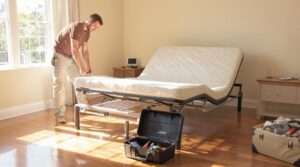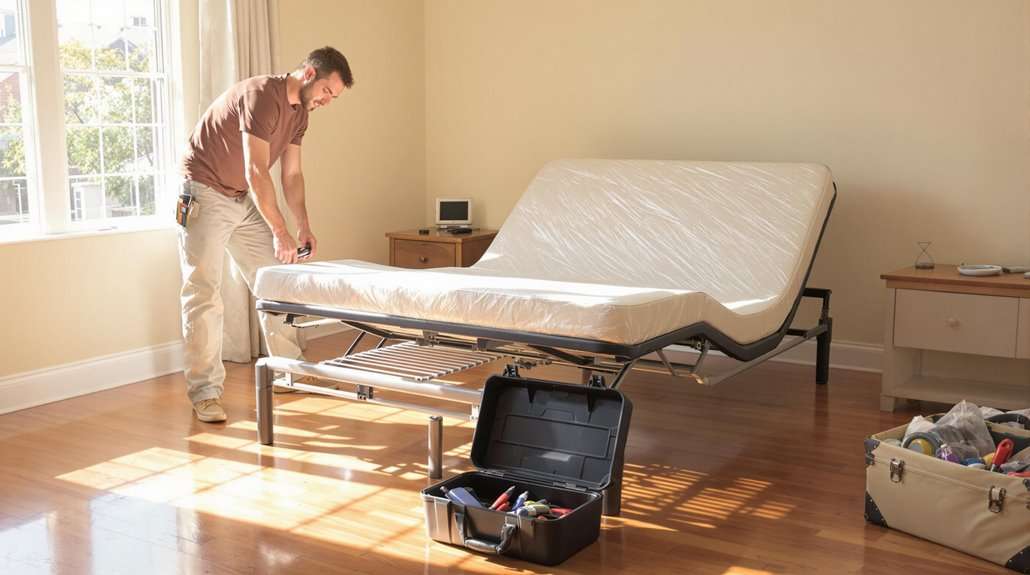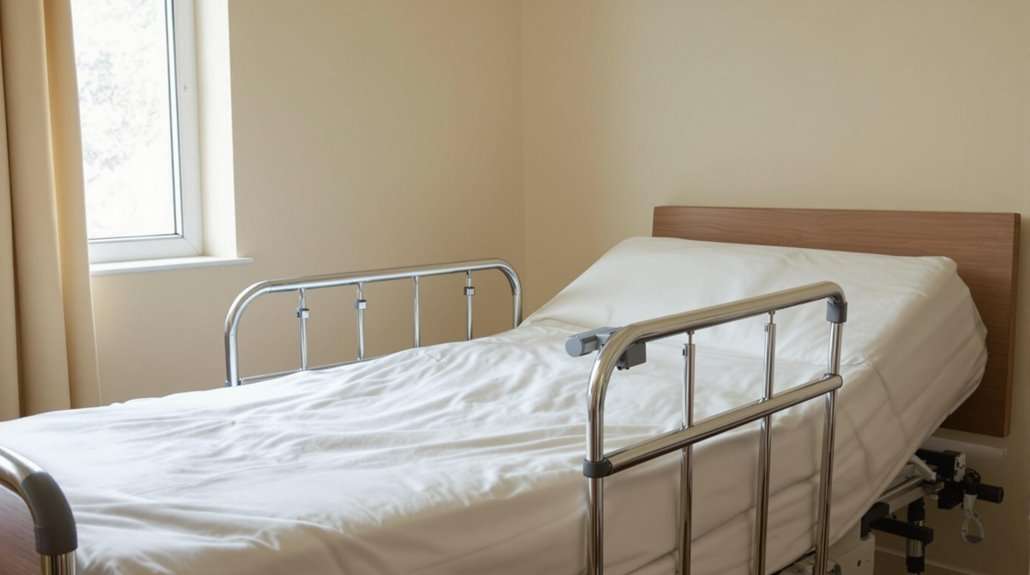Choosing the right mobility aid for seniors can be crucial for their independence and safety. Mobility aids have evolved, offering varied options beyond traditional canes and walkers.
This article guides you through selecting the appropriate device by considering individual needs, environmental factors, and types of aids available. Find out how to make an informed choice.
📋✅
- Talk with doctors to understand which mobility aid fits the senior’s daily needs and medical condition.
- Choose aids that match where the senior will use them, like indoors or outdoors, and consider different ground types.
- Pick a device that is easy to move, store, and matches the user’s size and weight.
- Think about costs and check if insurance covers the needed mobility aid.
- Get advice from healthcare providers for a safe fit and proper training on how to use the aid.
Understanding Individual Needs and Physical Capabilities

Choosing the right aid for moving around starts with knowing what the person needs and can do. This means looking at how well they move and any limits they have.
Assessing mobility requirements
Assessing mobility requirements means looking closely at what seniors need to move safely. Caregivers must consider several factors to help older adults stay active and independent.
- Talk with a doctor or a physical therapist about daily activity needs. They understand how medical conditions like arthritis or Parkinson’s disease affect movement.
- Have an occupational therapist do a mobility assessment. This expert can suggest the best assistive devices, from walkers to manual wheelchairs.
- Think about the senior’s grip strength and upper body strength. These decide if they can use crutches or need something more supportive like a wheelchair.
- Look at balance issues or risks of falling. Seniors with less balance may need quad canes for stability.
- Consider the need for indoor versus outdoor aids. Electric wheelchairs might work better outdoors, while walkers could be enough inside.
- Match devices with physical limitations. For example, forearm crutches might suit someone with stronger arms.
- Ensure the mobility device fits well in living spaces. Check if doorways are wide enough for wheelchairs or if grab bars are needed in bathrooms.
- Factor in whether the senior lives alone or has someone to help them use their device, such as assisting with a power scooter outside home.
Each step guides caregivers through picking the right aid that fits all aspects of a senior’s life, from their home layout to their personal strength and health condition.
Evaluating physical limitations
After assessing mobility requirements, we must look at physical limitations closely. Canes are good for those who need to support up to 25% of their body weight. Walkers take on up to 50%.
Signs like getting tired easily, feeling unstable, having trouble standing from a seat, and falling sometimes show the need for better support. Mobility scooters fit seniors who can use their arms well but can’t walk far.
“>Power scooters give freedom to those with arm strength but limited walking distance.”
Check how steady they feel and if rising from chairs is hard. These details help pick the right aid. If feet or legs are weak, consider rollators or walkers for balance. Scooters work when distances are too long for walking.
Each choice depends on clear needs and abilities.
Environmental Considerations
Think about where the senior will use the mobility aid. Some are better for inside the house, while others work well on different kinds of ground outside.
Indoor vs. outdoor usage
Choosing the right mobility device depends on where it will be used. Power scooters designed for indoors have different features than those made for outdoors. Indoor devices are usually smaller, making them easier to move around tight spaces like home corridors and rooms.
They often come with lighter frames and smaller wheels suitable for flat surfaces found inside a house.
Outdoor power wheelchairs and scooters need to handle various terrains, from sidewalks to grassy parks. These models are built tougher with larger wheels, more robust frames, and sometimes even suspension systems to tackle bumps and uneven paths easily.
Knowing these differences helps in picking a device that enhances mobility effectively in the desired setting.
Terrain adaptability
Rollators work well on different grounds and give a place to rest. They help people who use walking aids to move more freely outside. On the other hand, knee scooters struggle in tight areas or near stairs, limiting where they can go.
Transport chairs are good for quick trips but fail on bumpy paths. For older folks using a wheelchair or needing mobility devices, choosing the right tool means looking closely at where they will use it.
For every terrain challenge, there’s a mobility aid solution that can bring comfort and independence back into the lives of seniors.
Types of Mobility Aids
There are many tools to help people move around. These include sticks for walking, frames to hold onto, chairs with wheels, and motorized scooters.
Canes and crutches
Canes offer support, improve stability, and help relieve joint pressure. They come in different types like functional grip canes and quad canes to match a user’s specific needs. For seniors aiming for independent living, choosing the right cane ensures a better quality of life by conserving energy and enhancing balance.
Crutches demand greater upper-body strength and coordination than canes. They are ideal for individuals recovering from injuries or surgeries on the lower leg such as broken bones.
Using crutches properly involves learning correct techniques to avoid additional strain, making them less suitable for some older people with disabilities or those lacking physical dexterity.
Walkers and rollators
Walkers offer strong support for those who have severe balance issues and are at a high risk of falling. They make moving safer for users by providing a sturdy frame to lean on. Rollators, which come with wheels, also support walking but add more freedom.
They can move over different kinds of ground both inside and outside. This makes them great for people who want to keep active but need some help walking.
Both walkers and rollators have features that meet various needs. For example, rollators often have seats so the user can rest when tired. Choosing between these aids depends on how much support the person needs, where they will use it, and their lifestyle.
Wheelchairs (manual and power)
Moving from walkers to wheelchairs opens more diverse options for mobility. Manual chairs require a person’s strength or help from someone else to move. Standard ones weigh around 40 pounds, making them tough for some seniors.
For those needing something lighter, there are models at about 35 pounds covered by insurance if self-propelling is hard. The lightest option weighs roughly 28 pounds or less but might not be for everyone.
Power wheelchairs offer independence with various sizes and types available. They cater to different needs whether indoors or outdoors, fitting many environments seniors might find themselves in.
These powered models remove the need for physical strength to navigate, ensuring users can go where they please without much effort. From heavy-duty versions that handle rough terrain to compact designs fit for tight spaces, the choice depends on where and how one plans to use it.
Mobility scooters
Mobility scooters are easy to use and help seniors stay mobile. They have a tiller for steering. You can choose from basic, mid-range, or top-tier models depending on what you need.
Doctors must say that a senior needs a power scooter to move around their home.
For those whose lifestyle demands flexibility, mobility scooters offer the independence needed.
Key Features to Consider
When picking a mobility aid for an older person, think about how easy it is to carry and store, how much weight it can hold, and if you can adjust it to fit them right. Read more to find the perfect help for walking or moving around.
Portability and storage
Choosing a mobility aid means looking at how easy it is to move and store. Transport chairs stand out because they’re light and simple to carry around. This makes them great for travel.
Think about whether the mobility aid can fold up. If it can, you’ll have an easier time putting it in a car or finding space for it at home. Devices that are bulky or hard to break down might not work well if you often go places with the senior you care for.
Also, consider weight limits and size of the mobility aid. It needs to fit through doors easily and hold up under the user’s weight without trouble. Some aids come in different sizes, so picking one that matches the senior’s body type is key.
For storage, check if there are extra parts like baskets that need space too. Making sure your choice fits well in daily life reduces stress for both you *and* the person using it.
Weight capacity and dimensions
For safety and comfort, choose a mobility aid that can hold the user’s weight. Each aid has a limit on how much weight it can handle. Measure the senior’s height and weight before picking one.
This ensures the chosen device, like walkers or wheelchairs, fits well and prevents falls or discomfort.
Check the size of doorways and halls at home too. The dimensions of mobility aids matter for moving around easily indoors. If a walker is too wide, it might not go through narrow spaces smoothly.
Measure these areas to make sure your selected aid, whether it be rollators or walking sticks, will fit through without trouble.
Accessibility features and adjustability
Choosing the right mobility aid means focusing on accessibility features and how they adjust. These elements can make a big difference in comfort and independence.
- Adjustable seat heights cater to users of different sizes. This ensures that the person can sit comfortably without straining their legs or back.
- Removable footrests allow for easy transfers in and out of the chair, reducing strain on both caregiver and user.
- Lifting seats support individuals when sitting down or standing up, making it safer for those with limited mobility.
- Storage bag options offer a place to keep personal items secure, enhancing convenience during outings.
- Armrest adjustability aids in finding the optimal position for arm support, crucial for maintaining balance and comfort.
- Lightness and foldability enhance portability. A lighter frame means easier handling, especially when loading into a vehicle or storing at home.
- Durability guarantees long-term use without frequent replacements, offering peace of mind regarding reliability.
- Weight capacity must match the user’s weight to ensure safety and stability while using the device.
- Dimension considerations ensure the mobility aid fits through doorways and within living spaces comfortably.
Every feature mentioned aims to enhance ease of use, safety, and adaptability to various daily activities and environments for seniors needing assistance with mobility.
Financial Considerations
Money matters when choosing a helper device for walking or moving around. Check the price and see if insurance can help pay for it.
Cost analysis
Cost analysis for selecting mobility aids involves understanding various financial aspects. These include the purchase price, insurance coverage, and maintenance expenses. Insurance policies usually cover only the basic mobility aids. It’s essential to check with insurance providers to understand what is covered and what is not. Here’s a concise table summarizing cost-related considerations for caregivers:
| Aspect | Details |
|---|---|
| Purchase Price | Varies widely based on type (canes, walkers, wheelchairs, scooters) and features. |
| Insurance Coverage | Mostly covers basic models; check policy for specifics. May require a doctor’s prescription. |
| Maintenance | Includes ongoing costs for repairs and replacements. Price depends on usage and mobility aid type. |
| Budget Planning | Factor in initial costs plus maintenance. Explore insurance options and out-of-pocket expenses. |
Choosing the right mobility aid requires careful financial planning. Assess the total cost, including purchase, insurance coverage, and future maintenance expenses. Ensure the selected mobility aid meets the senior’s needs within the available budget.
Insurance coverage and budget planning
Picking the right mobility aid means looking at costs and insurance. Understand what insurance covers and plan your budget well.
- Check the senior’s insurance plan closely. It should detail coverage for mobility aids like wheelchairs or scooters.
- Verify if a doctor’s prescription specifies that a power scooter is essential for home mobility. This step is crucial for insurance coverage.
- Find out the diagnosis needed for an insurance company to cover a power wheelchair. Each person’s coverage varies based on their specific health condition.
- Compare prices of various mobility aids such as walkers, rollators, and canes to find one that fits your budget without sacrificing need.
- Look into Medicare or Medicaid plans for additional assistance in covering costs of necessary equipment.
- Explore options for used or refurbished equipment which can be more affordable but equally effective.
7: Ask healthcare providers about rental options which might be cheaper for short-term needs.
Next, let’s consider seeking advice from healthcare professionals for more guidance.
Professional Guidance
Talking to a healthcare provider can guide you in choosing the right mobility aid. They know your health and can suggest devices that fit best.
Seeking advice from healthcare professionals
Talking to health care providers is key in choosing the right mobility aid. They know about medical equipment. This includes things like wheelchairs and rolling walkers. They make sure it fits right and teach how to use it safely.
It’s also a way to check if insurance will help pay for it.
A proper fit and training from a healthcare professional can greatly improve safety and independence.
Doctors or physical therapists often suggest trials. This means trying out different aids like manual wheelchairs or crutches before buying them. Testing helps find what works best for someone’s needs, indoors or outdoors, without wasting money.
Importance of personalized fitting and trials
Getting the right fit and trying out mobility aids ensures safety for seniors. An occupational therapist or physical therapist can check how a senior moves and suggests the best equipment.
This step prevents accidents and boosts their quality of life. For example, they might recommend underarm crutches for someone with balance issues or a power wheelchair for those who tire easily.
During trials, seniors learn to use these aids correctly. Proper training on how to navigate with a walker or adjust a wheelchair is crucial. It makes sure the senior feels confident and mobile, whether indoors or outdoors.
Plus, regular check-ups ensure these aids keep working well over time, helping avoid future falls or injuries.
Choosing the right mobility aid for seniors takes careful thought. Assess their daily needs and physical limits first. Think about where they will use it, like indoors or outdoors, and what type of ground they will move on.
Look at different aids such as canes, walkers, wheelchairs, and scooters to find a good match. Consider each option’s size, weight limit, and how easy it is to store or carry. Check costs and if insurance might help pay for it.
Always get advice from medical professionals to ensure the best fit for safety and independence.
Additional Resources
For more help on picking the right help for moving around, read about how to choose a good medical alert system for someone older who you care for. This guide offers insight into picking devices that keep them safe.
How to Choose the Right Medical Alert System for an Elderly Loved One
Choosing the right medical alert system for an elderly loved one means considering their unique needs and your budget. Look at devices that fit well with their daily life, whether they stay mostly indoors or love spending time outside.
Some systems have features like fall detection and GPS tracking which are great for those with balance issues or who enjoy walks. Also, check if the system is easy to use for someone with vision problems or physical limitations.
Cost is a big factor too. Find out if your insurance covers any of the costs and compare prices between different models. It’s also smart to ask healthcare professionals, possibly a physiotherapist who understands your loved one’s condition, for recommendations.
They can help you decide on a system that boosts safety without sacrificing independence.
Safety and independence for our loved ones come first in choosing the right medical alert system.
Related Questions
1. What is the role of a medical professional in the decision-making process for selecting mobility aids for seniors?
A medical professional’s expertise is crucial when choosing an assistive technology like a wheelchair, brace, or stairlift. They consider factors such as chronic pain, cerebellar disease, and stroke history.
2. How does mental well-being influence the choice of mobility aid?
Mental well-being impacts attitudes towards using mobility aids. For instance, some wheelchair users may prefer one type over another for comfort or independence reasons.
3. Do specific health conditions require particular types of mobility aids?
Yes, certain health conditions necessitate specific aids – amputees might need a prosthetic limb while those with osteoarthritic hips may benefit from a shopping cart-style walker.
4. Are there special considerations for hemiplegic seniors when choosing a mobility aid?
Hemiplegic seniors often face proprioceptive and vestibular challenges affecting balance and spatial awareness; thus their needs should be considered carefully during selection.
5. How do physical environment factors affect the selection of senior mobility aids?
Physical environment aspects such as door knob designs and stair presence can impact whether a wheelchair or stairlift would be more suitable to ensure proper caregiving.









